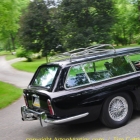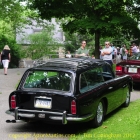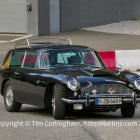The conversion was extensive and affected the whole car from the windscreen backwards. One problem with the conversion was that the tubular structure of the roof was cut away and the new extended roof was supported by steel fabrications thus reducing the inherent rigidity of the original vehicle. The rear hatchback was a single piece hinged from the top and assisted by springs.
The interior was cleverly designed to hold as much as stuff as possible. With the rear seat folded down, the car offered an uninterrupted payload platform of 1.75 meters by 1 .05 meters and a volume of 1.1 cubic meters, although with suspension unaltered, it would have been unwise to carry a large deal of additional weight.
As the mechanical and chassis specification of the car remained the same as when first built, Radford still claimed to reach 150 mph and was marketed with the tag-line ‘The world’s fastest dual-purpose vehicle’. Also Radford claimed the Shooting Brake would be able to brake from 100 mph to a standstill in 6 seconds, although we must assume this is without a heavy payload in the back. As each shooting brake began life as a completely finished DB6 saloon, the additional conversion to a shooting brake added more than £2,000 to the cost.
The example shown on this page is a Radford converted car and has lived in the US for many years.
In addition to the Radford converted cars, two or maybe three DB6’s were converted to Shooting Brakes by FLM Panelcraft, another London coachbuilding company.






















